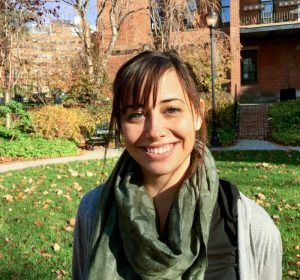Physicists in the College of Arts and Sciences are using a major grant to study the cellular uptake of SARS-CoV-2 (SARS2), the virus responsible for coronavirus disease 2019, or COVID-19.
The National Science Foundation (NSF) has awarded Assistant Professor Alison Patteson and Associate Professor Jennifer Schwarz a $196,000 grant to investigate the link between vimentin, a chain of proteins founds in animal cells and bacteria, and SARS2 cell entry. The award, Patteson’s first from NSF as a principal investigator, is part of the agency’s Rapid Response Research (RAPID) initiative, supporting better treatment for COVID-19.

“New evidence suggests that vimentin is present on the extracellular surface of cells and plays a critical role in the binding and uptake of multiple viruses. The mechanism by which this happens, however, is unclear,” Patteson says.
Part of the answer may reside in the cell’s skeleton, known as the cytoskeleton. Vimentin helps form the cytoskeleton, a series of protein filaments that gives the cell its shape and structure. The Patteson lab is interested in the role of these cytoskeletal networks in cell movement and mechanics.

“We are turning to extracellular vimentin to determine its role in the uptake of SARS2 and to find ways to block its entry into the cell,” she says. “Such information may help us understand how coronaviruses, in general, infect cells.”
While there are many kinds of coronaviruses, only a few cause disease. COVID-19 is a type of coronavirus spread through droplets released into the air when an infected person coughs or sneezes. According to the World Health Organization, there are more than 11.7 million global cases of COVID-19, for which there is no vaccine.
“In rare cases, COVID-19 can lead to severe respiratory problems, kidney failure or death,” says Schwarz, the project’s co-principal investigator. She and Patteson are part of the Soft Matter Group in the Department of Physics as well as the University’s new BioInspired Institute.
The duo is collaborating with colleagues from the Polish Academy of Sciences in Kraków, the Medical University of Bialystok (Poland) and Northwestern Medicine. In addition to physics, their RAPID project combines elements of biology, chemistry and engineering.
“There is an urgent need for this information, as we have an incomplete understanding of how SARS2 enters the cell,” Patteson says. “It’s likely that vimentin mediates how SARS2 interacts with the surface of the cell and possibly increases the virus’s uptake by the cell.”
A full understanding of how SARS2 invades cells is critical to the development of antiviral drugs to combat COVID-19.
This RAPID grant is awarded by the Cellular Dynamics and Functional Program in NSF’s Division of Molecular and Cellular Biosciences, using funds from the Coronavirus Aid, Relief and Economic Security (CARES) Act.
